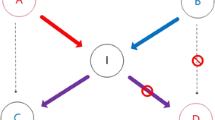Abstract
Two rate control algorithms with distributed joint diversity and power control are proposed for wireless networks. We prove that with the proposed algorithms, the allowed transmitting rate can converge to the individual rate requirement with which the QoS requirement can be satisfied, and each user can share the bandwidth according to the pre-specified setting so that certain fairness can be maintained among the users in the same cell. Simulation results also show that the scheme with rate control gains larger throughput than the scheme without rate control.
Similar content being viewed by others
References
Rashid-Farrokhi, F., Tassiulas, L., & Liu, K. J. R. (1998). Joint optimal power control and beamforming in wireless networks using antenna arrays. IEEE Transactions on Communications, 46(10), 1313–1324.
Mercado, A., & Liu, K. J. R. (2002). Adaptive QoS for wireless multimedia networks using power control and smart antennas. IEEE Transactions on Vehicular Technology, 51(5), 1223–1233.
Olfat, M., Rashid-Farrokhi, F., & Liu, K. J. R. (2005). Power allocation for OFDM using adaptive beamforming over wireless networks. IEEE Transactions on Communications, 53(3), 505–514.
Zander, J. (1992). Performance of optimum transmitter power control in cellular radio cellular systems. IEEE Transactions on Vehicular Technology, 41(1), 57–62.
Zander, J. (1992). Distributed cochannel interference control in cellular radio systems. IEEE Transactions on Vehicular Technology, 41(3), 305–311.
Yates, R. D. (1995). A framework for uplink power control in cellular radio systems. IEEE Journal on Selected Areas in Communications, 13(7), 1341–1347.
Lee, T. H., & Lin, J. C. (1996). A fully distributed power control algorithm for cellular mobile systems. IEEE Journal on Selected Areas in Communications, 14(4), 692–697.
Wang, J. T. (2007). Optimal joint dual transmitter receiver diversity and power control for wireless networks. IEEE Communications Letters, 11(1), 46–48.
Lee, W. C. Y. (1986). Elements of cellular mobile radio. IEEE Transactions on Vehicular Technology, VT-35, 48–56.
Kim, D. (1999). Rate-regulated power control for supporting flexible transmission in future CDMA mobile networks. IEEE Journal on Selected Areas in Communications, 17(5), 968–977.
Kim, S. W., & Lee, Y. H. (2000). Combined rate and power adaptation in DS/CDMA communications over Nakagami fading channels. IEEE Transactions on Communications, 48(1), 162–168.
Wang, J. T. (2004). Integrated power and rate control for data applications over CDMA wireless networks. Electronics Letters, 40(18), 1130–1131.
Wang, J. T. (2009). Ratioed power and rate control for CDMA wireless networks. Wireless Communications and Mobile Computing, 9(2), 227–237.
Haykin, S. (1991). Adaptive filter theory. New York: Prentice Hall.
Author information
Authors and Affiliations
Corresponding author
Rights and permissions
About this article
Cite this article
Wang, J.T. Rate control with distributed joint diversity and power control for wireless networks. Telecommun Syst 53, 169–178 (2013). https://doi.org/10.1007/s11235-011-9526-0
Published:
Issue Date:
DOI: https://doi.org/10.1007/s11235-011-9526-0




